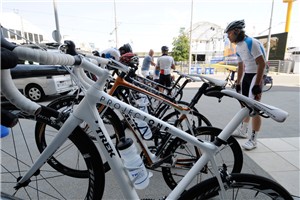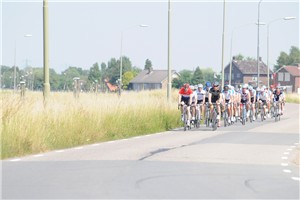
Image Geoff Waugh 2010


Image Geoff Waugh 2010

Image Geoff Waugh 2010
What better venue for the launch of the 2011 Trek Madone range than the venue for the prologue of the 2010 Tour de France? Thus it was that the usual motley crew of journalists checked in to the Rotterdam Tulip Inn, immediately adjacent to the Erasmus Bridge over which the prologue would pass a couple of days later, ready and indeed eager to be told all about the huge technological advances embedded in the successors to the hugely successful 2010 Madones.
We arrrived in time to see the team presentation, which took place on a platform about 50m from the hotel’s front door. This was a bonus, unlike the inevitable clearing-up process which, involving a fork lift truck with constant beep, went on until the small hours of the morning.
Nevertheless, we were in buoyant mood for the start of Trek’s presentation; the sun was shining outside, the temperature was rapidly rising towards a very un-Dutch 35degC or more and we’d been promised a ride on the top new Madone, the 6.9 SSL, that very afternoon.
The good mood remained even after the stunning revelation that Trek’s magic number right now is 37. Of course, this started to make sense once we’d been informed that the Wisconsin firm has 37 specialist carbon-fibre engineers, some of whom are qualified rocket scientists. We were shown the series of equations used by Trek to calculate the properties to be expected from a component manufactured by someone who knows how to apply the equations.
Yes, yes; where’s the new bike and how much better is it? There were several examples on stands to look at prior to the presentation and those of us expecting and wanting a whole new shape with even more organic curves, a fatter down tube and, perhaps, some new bottom bracket standard to supersede BB30, BB90 and the rest were left puzzled. The new frame looked the same as the old. Exactly the same.
Indeed, the outward appearance of the 5 Series Madones is the same and, inevitably, someone piped up to ask why a buyer would go for the new 6.9 SSL when the 5.9 – or 5.2 for that matter, looks identical in shape.
The answer lies, as ever with Trek, under the paintwork. Or nude lacquer, which is lighter. The latest fibre is called HexSL and is said to reconcile the previously irreconcilable carbon polarities of strength and stiffness. Until HexSL, more of one meant less of the other and the need to mix them to obtain enough of each. HexSL, having a surfeit of both, can be used on its own, saving a lot of fibres and a fair bit of weight with no fall-off in performance.
How do Trek figure how much stiffness they actually need? By making lots of frames, each with different properties precisely repeatable using those equations, and then riding them. Frames had been made, we were told in awed tones, that were as stiff as those raced by a pro team on one of Trek’s less immediate competitors…
So, lunched on a finger buffet and hot from a stroll back over the Erasmus Bridge, we stuffed ourselves into the Bontrager clothing provided, each grabbed a fresh new Dura-Ace-equipped Madone 6.9 SSL, fiddled with it until satisfied and set off on a group ride to see the spiritual home of Dutch cheese – Gouda.
The ride was hot – 38degC hot according to the Bonty computer, linked to the DuoTrap sensor in the left-hand chainstay, on my handlebars until it gave up the struggle and switched off. As ever in the Netherlands, we stuck to cycle paths where they were available, which presented unexpected hazards to a 25-rider bunch. Scooters use these paths, their riders invariably without a helmet and unconcerned by the prospect of an approaching peloton. There are potholes, parked cars, on one occasion a reversing fuel delivery lorry and, most hazardous of all, 1m high orange-painted posts to avoid.
Or not, as was the case with the editor of one of the UK’s leading monthly general interest road cycling magazines, who failed to note the avoiding swerve of the rider in front of him in the bunch. Presented at 20mph with the post, said editor claimed to have leapfrogged it while still in the saddle. His claim was backed up by a scuffed top tube and reddened thigh; apparently, he flung his 6.9 SSL to one side of the post and, having unclipped, his leg to the other. The impact with the top tube bounced him sideways and he was impressed with the Madone’s inherent stability, although not as impressed as we were with his skills.
And the bikes? Having been riding a 6.9 RadioShack team replica for a couple of months, I can say that the SSL felt indistinguishable although the brakes were feeble compared to the SRAM RED calipers on my long-termer. Just as stiff and seemingly just as comfortable and with a claimed weight loss of 100g. HexSL? Lance is riding it even now.


